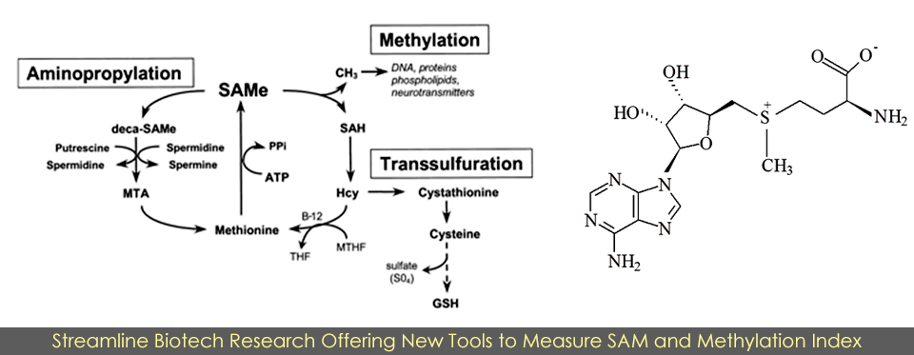The SAM Molecule
A Necessary Chemical

S-Adenosylmethionine (SAM-e, SAMe, SAM, AdoMet, ademetionine) was discovered in Italy by G. L. Cantoni in 1952. It is made from Adenosine Triphosphate (ATP) and Methionone by Methionine Adenosyltransferase. S-adenosylmethionine is a critical metabolite in most living organisms. It performs important functions of transmethylation, transsulfuration, and aminopropylation through decarboxylation.
Since SAM is an intrinsically unstable molecufle, and its optical density maximum of 258-260 nm is not a distinguished absorption, the determination of its concentration in various biological fluids and tissues has always been a challenging task. A simple, convenient method that does not require costly instrumentation (LC, MS, and combinations) is clearly desirable for the determination of the biological concentration of SAM, and to monitor its change and metabolic paths in the body fluids, tissues and organelles.
SAM-e is claimed to be helpful for the following conditions: Depression, Parkinson’s Disease, Osteoarthritis symptoms, Liver disease, Intrahepatic Cholestasis (of pregnancy especially), Fibormyalgia, AIDS-related myelopathy (a spine and nerve disorder associated with AIDS). There has be also limited research that has referenced for SAMe’s role in the following conditions: Attention deficit hyperactivity disorder (ADHD), Premenstrual syndrome (PMS), Premenstrual dysphoric disorder (PMDD), Chronic fatigue syndrome (CFS), heart disease, defective intellectual performance, multiple sclerosis, dementia, Alzeimer’s disease, tendonitis, bursitis, spinal cord injury, seizure, migraine headache, chronic low back pain, lead poisoning and aging.
It is also critically necessary to understand the impact and consequence when SAM is being used daily as a nutritional supplement these days. It has been widely used as over-ther-counter medicine to relieve systems of depression, osteoarthristis and so on.
Methylation
Methylation is involved in nearly every aspect of life. SAM is the sole methyl donor for a variety of methyl-transfer reactions in DNA, RNA, proteins, lipids, phosphilipids, hormones and neurotransmitters. Proper DNA methylation is essential for normal embryonic development. However, when the methyl-transferase gene is homozygously deleted, it is lethal.
DNA improperly methylated has been found in many tumors. Alterations in DNA methylation patterns induce the expression of oncogenes or silence the expression of tumor-suppressor genes. Methyl-deficient diets promote liver cancer in rodents.
Vital Processes
DNA Methylation results in protection of the genome from restriction enzymes. SAM controls gene expression by binding to structural domains embedded within the non-coding region of certain mRNAs. SAM provides the methyl group in the production of essential bio-molecules, including:
| • Acetyl-L-Carnitine: The Neuronutrient & Membrane-Transporting Agent • Epinephrine & Adrenalin: The Endogenous Catecholamfine, Stress Hormone, & Neurotransmitter • Phosphatidylcholine: The Most Important Membrane Phospholipids |
• Carnitine: The Fat Burner • Phosphocreatine: The Primary ATP Reservoir • Melatonin: Circadian Rhythm Modulator |
SAM is required for cellular growth and repair. It is also involved in the biosynthesis of several hormones and neurotransmitters that affect mood, such as epinephrine. Methyltransferases are also responsible for the addition of methyl groups to the 2′ hydroxyls of the first and second nucleotides next to the 5′ cap in messenger RNA.
Transsulfuration
The transsulfuration begins with S-adenosylhomocysteine, or SAH, which is the residual structure of S-adenosylmethionine (SAM) upon transfering methyl group out of SAM. Hydrolysis of SAH yields homocysteine. This converts to cystathionine, cysteine, and finally to glutathione, the hepatocellular antioxidant and life-saving detoxification agent. Since dietary cysteine content is low, and up to 80% of dietary cysteine loses its sulfhydryl groups through the gastrointestinal tract, SAM is the main source of cysteine, the building block of glutathione. As an antioxidant, it protects the body from damaging reactive oxygen molecules in the body. These reactive oxygen molecules can come from inside the body or from environmental pollution and are thought to play a role in the aging process and the development of degenerative disease. In general, SAMe is thought to raise the level of functioning of other amino acids in the body.
Aminopropylation
The aminopropylation is another process initiated with SAM through decarboxylation (decarboxylase). The decarboxylated SAM then couples with putrescine to generate spermidine and spermine which are critical to cell growth, differentiation and the stability of DNA and RNA. Furthermore, Methylthioadenosine (MTA), the by-product of polyamine synthesis, is a powerful analgesic and anti-inflammatory agent. This may be, at least partially, responsible for the clinical benefits observed in the treatment of osteoarthritis, rheumatoid arthritis and fibromyalgia with SAMe.